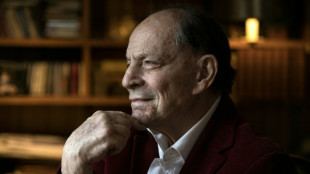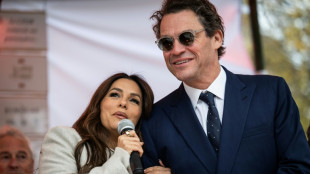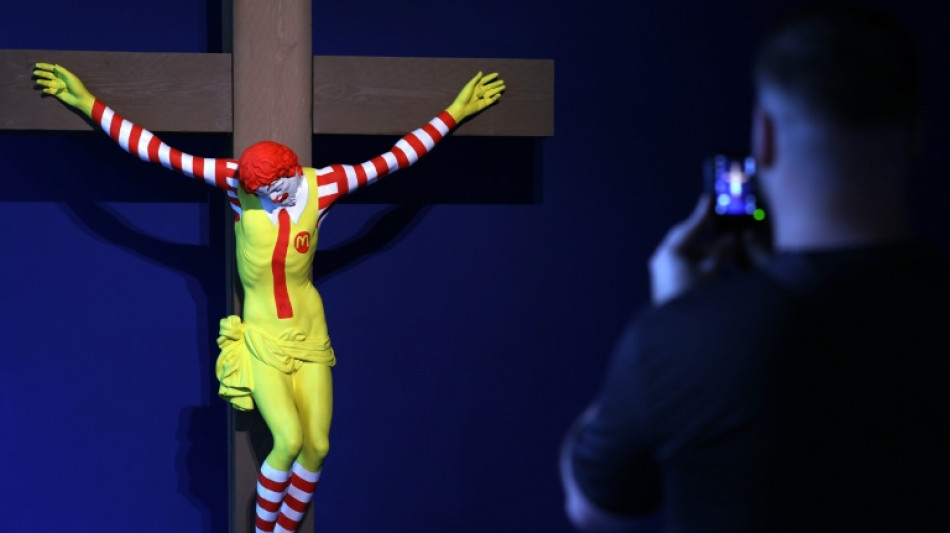
-
 Markets rally after US bounce as Nvidia comes into focus
Markets rally after US bounce as Nvidia comes into focus
-
Crisis-hit Thyssenkrupp books another hefty annual loss

-
 US envoy in Lebanon for talks on halting Israel-Hezbollah war
US envoy in Lebanon for talks on halting Israel-Hezbollah war
-
India to send 5,000 extra troops to quell Manipur unrest

-
 Sex, drugs and gritty reality on Prague's underworld tours
Sex, drugs and gritty reality on Prague's underworld tours
-
Farmers descend on London to overturn inheritance tax change

-
 Clippers upset Warriors, Lillard saves Bucks
Clippers upset Warriors, Lillard saves Bucks
-
Acquitted 'Hong Kong 47' defendant sees freedom as responsibility

-
 Floods strike thousands of houses in northern Philippines
Floods strike thousands of houses in northern Philippines
-
Illegal farm fires fuel Indian capital's smog misery

-
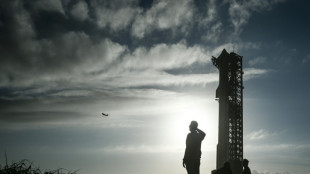 SpaceX set for Starship's next flight, Trump expected to attend
SpaceX set for Starship's next flight, Trump expected to attend
-
Texans cruise as Cowboys crisis deepens

-
 Do the Donald! Trump dance takes US sport by storm
Do the Donald! Trump dance takes US sport by storm
-
Home hero Cameron Smith desperate for first win of 2024 at Australian PGA

-
 Team Trump assails Biden decision on missiles for Ukraine
Team Trump assails Biden decision on missiles for Ukraine
-
Hong Kong court jails 45 democracy campaigners on subversion charges

-
 Several children injured in car crash at central China school
Several children injured in car crash at central China school
-
Urban mosquito sparks malaria surge in East Africa

-
 Djibouti experiments with GM mosquito against malaria
Djibouti experiments with GM mosquito against malaria
-
Pulisic at the double as USA cruise past Jamaica

-
 Many children injured after car crashes at central China school: state media
Many children injured after car crashes at central China school: state media
-
Asian markets rally after US bounce as Nvidia comes into focus

-
 Tens of thousands march in New Zealand Maori rights protest
Tens of thousands march in New Zealand Maori rights protest
-
Five takeaways from the G20 summit in Rio

-
 China, Russia ministers discuss Korea tensions at G20: state media
China, Russia ministers discuss Korea tensions at G20: state media
-
Kohli form, opening woes dog India ahead of Australia Test series

-
 Parts of Great Barrier Reef suffer highest coral mortality on record
Parts of Great Barrier Reef suffer highest coral mortality on record
-
Defiant Lebanese harvest olives in the shadow of war

-
 Russian delegations visit Pyongyang as Ukraine war deepens ties
Russian delegations visit Pyongyang as Ukraine war deepens ties
-
S.Africa offers a lesson on how not to shut down a coal plant

-
 Italy beat Swiatek's Poland to reach BJK Cup final
Italy beat Swiatek's Poland to reach BJK Cup final
-
Japan, UK to hold regular economic security talks

-
 Divided G20 fails to agree on climate, Ukraine
Divided G20 fails to agree on climate, Ukraine
-
Can the Trump-Musk 'bromance' last?

-
 US to call for Google to sell Chrome browser: report
US to call for Google to sell Chrome browser: report
-
Macron hails 'good' US decision on Ukraine missiles

-
 Italy eliminate Swiatek's Poland to reach BJK Cup final
Italy eliminate Swiatek's Poland to reach BJK Cup final
-
Trump expected to attend next Starship rocket launch: reports
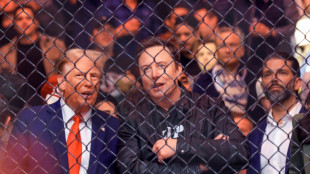
-
 Israeli strike on Beirut kills 5 as deadly rocket fire hits Israel
Israeli strike on Beirut kills 5 as deadly rocket fire hits Israel
-
Gvardiol steals in to ensure Croatia reach Nations League quarter-finals

-
 Thousands march to New Zealand's parliament in Maori rights protest
Thousands march to New Zealand's parliament in Maori rights protest
-
China's Xi urges G20 to help 'cool' Ukraine crisis

-
 Church and state clash over entry fee for Paris's Notre Dame
Church and state clash over entry fee for Paris's Notre Dame
-
Holders Spain strike late to beat Switzerland in Nations League

-
 Stocks, dollar hesitant as traders brace for Nvidia earnings
Stocks, dollar hesitant as traders brace for Nvidia earnings
-
Swiatek saves Poland against Italy in BJK Cup semi, forces doubles decider

-
 Biden in 'historic' pledge for poor nations ahead of Trump return
Biden in 'historic' pledge for poor nations ahead of Trump return
-
Sudan, Benin qualify, heartbreak for Rwanda after shocking Nigeria

-
 Five dead in new Israeli strike on Beirut's centre
Five dead in new Israeli strike on Beirut's centre
-
Where's Joe? G20 leaders have group photo without Biden


'Extraordinary' museum of censored art opens in Spain
A crucified Ronald McDonald clown, prayer mats adorned with stilettos and sketches by former Guantanamo prisoners take pride of place at a new museum in Spain devoted to previously censored art.
The private Museum of Forbidden Art, which opened to the public in Barcelona on Thursday, features 42 works from around the world that have been denounced, attacked or removed from exhibition.
Works by artists such as Spanish master Francisco de Goya, US cultural icon Andy Warhol and Chinese artist and activist Ai Weiwei are spread over two floors.
The objects are part of a collection of 200 such works belonging to Tatxo Benet, a Catalan businessman.
While they push boundaries and often sparked controversy, Benet said this was not enough to be included in the museum, located in the centre of the Catalan capital, one of the world's most visited cities.
"We don't collect or show scandalous or controversial works in the museum. We show works in the museum that have been censored, assaulted, violated, banned," he told AFP.
"Works that have a history behind them, without that history they wouldn't be here," he added.
- 'Always have a place' -
Many works deal with religion, such as Finnish artist Jani Leinonen's "McJesus" of a Ronald McDonald sculpture crucified to a wooden cross, which was withdrawn from a museum in Israel.
The museum also showcases a photograph of a crucifix submerged in the urine of New York artist Andres Serrano, which was vandalised during an exhibition in France and sparked an uproar when first shown in the United States in 1989.
Another highlight is a work by French-Algerian artist Zoulikha Bouabdellah featuring 30 Muslim prayer mats, each adorned with a pair of sequinned stilettos, which was pulled from an exhibition in France in 2015 following complaints from a Muslim group.
Benet, one of the founders of Spanish multimedia group Mediapro, said he started building his collection in 2018 when he bought an installation called "Political Prisoners in Contemporary Spain".
It consisted of black-and-white photos with pixellated faces of people who had broken the law, among them Catalan separatist leaders who faced legal action over a failed 2017 secession bid.
The work, by Spanish artist Santiago Sierra, was pulled from a Madrid art fair just two hours after Benet bought it. It is now on display at another museum in the Catalan city of Lleida.
The museum also displays paintings and sketches by former prisoners at the US naval base at Guantanamo Bay in Cuba, including one of the Statue of Liberty submerged in water with only the hand holding a torch and top of the crown visible.
The US government ordered that art made by inmates at the detention centre would have to be destroyed when they are released after an exhibition of works in New York in 2017 sparked controversy.
"Any artist who can't show their work because someone prevents them from doing so is an artist who is censored, and therefore will always have a place in this museum," Benet said.
- 'Amazed' -
Benet was speaking a few metres from a self-portrait of late US artist Chuck Close, known for his massive photorealistic portraits.
The National Gallery of Art in Washington gave up dedicating an exhibition to Close's works after several women accused him of sexually harassing them several years earlier when they came to his studio to pose.
Benet said having so many controversial works together caused visitors' "levels of tolerance to widen and the level of scandal of the work to be lowered".
Corinna Dechateaubourg, a 56-year-old German who was visiting from Hamburg on the exhibition's opening day, said she kept looking up more information on the works on her mobile phone.
"I'm amazed, it's extraordinary, it's really interesting," she told AFP.
Montserrat Izquierdo, a 67-year-old Spaniard, said "it is good to be able to see what is forbidden, what you are not allowed to see normally".
A.Williams--AT

